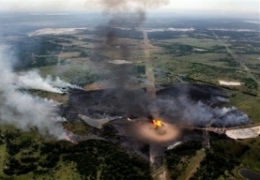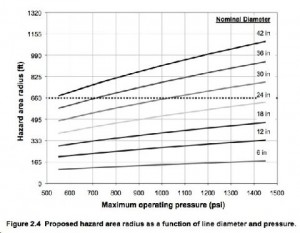The Blast Radius: What Does it Mean For Your Neighborhood?
From an Article by Richard Averett, December 20, 2014
Note the blast radius as defined by the white smoke at the edge of the burned area.
We’ve been provided a report from the Pipeline Saftey Trust that was done for the Gas Research Institute (the gas industry) in October 2000 by C-FER Technologies which has some revealing information about the “blast radius” of a pipeline explosion. The blast radius is the distance that the fire from the explosion consumes, measured in feet from the epicenter to the outer edge of the burned area.
We’re interested in understanding how the blast from a pipeline explosion will affect Jersey City in terms of death, injury and property damage. This report gives some insight into what to expect.
As if the study wasn’t bad enough, the data collected from actual explosions paints a bleaker picture.
Findings [Read: The full report ]
The title of this report, “A Model for sizing High Consequence Areas” (HCA) is described as follows.
The definition of High Consequence Areas is expected to require additional protection for people with limited mobility such as day care centers, old age homes, and prisons. This report suggests the definition for the HCA area of increased protection be set by two parameters, the pipe diameter and it’s operating pressure.
Jersey City certainly qualifies as a HCA as we have many schools, pre-schools, day care centers, retirement homes and hospitals adjacent to the pipeline’s proposed path.
Furthermore, the report acknowledges that natural gas pipelines “rupture” carry “a significant threat.”
The rupture of a high-pressure natural gas pipeline can lead to outcomes that can pose a significant threat to people and property in the immediate vicinity of the failure location. The dominant hazard is thermal radiation from a sustained fire and an estimate of the ground area affected by a credible worst-case event can be obtained from a model that characterizes the heat intensity associated with rupture failure of the pipe where the escaping gas is assumed to feed a fire that ignites very soon after line failure.
How Big of a Blast Radius Are We Talking About?
According to the Report
Spectra has stated in their pre-filing application with FERC for the “New Jersey – New York Expansion Project”, that the diameter of pipeline will be 30″, approximately 15 miles through Jersey City operating at a minimum of 800 PSI (pounds per square inch) to a maximum pressure of 1440 PSI. This is a standard for transmission of natural gas across many miles.
According to Public Pipeline Failure Incidents
The data on actual pipeline failure incidents tells a slightly different story as many actual incidents report a greater radius of burn than does the actual graph established by this report.
For instance, a blast near Bealeton, Virginia (1975 NTSB-PAR-75-2) burned a radius of 700 feet at less than 800 PSI – the minimum operating pressure Spectra will run through Jersey City – when the chart above shows burn radius should have been no more than approximately 525 feet.
Thus the actual burn radius was 75% greater than hypothesized.
Another incident involving a 30″ pipe was near Jackson, Louisiana (1984 NTSB-PAR-86-1) burned an area 1450 feet long by 360 feet wide (furthest fire extent 950 feet) while operating at 1016 PSI which claimed 5 lives within 65 feet (0 foot offset) and 23 injuries within 800 feet (180 foot offset).
The actual burn radius for this incident is 45 to 52% greater than the 660 foot burn radius hypothesized.
See also: http://nogaspipeline.org/2010-08-19/the-blast-radius | nogaspipeline@gmail.com



{ 3 comments… read them below or add one }
Of course, those of us living in “low consequence areas” are hardly reassured by knowing that we don’t matter as much.
sigh … Sheila Stone
As a State Certified Real Estate Appraiser, I have concerns as to how this blast area could affect property values.
In the past, I saw a site that had a list of the “blast zone” by pipeline size. Wish I could still find that.
JSeems to have ‘went away”.
Each city seems to have their own ‘blast zone’ ordinance and restricts building within this area.